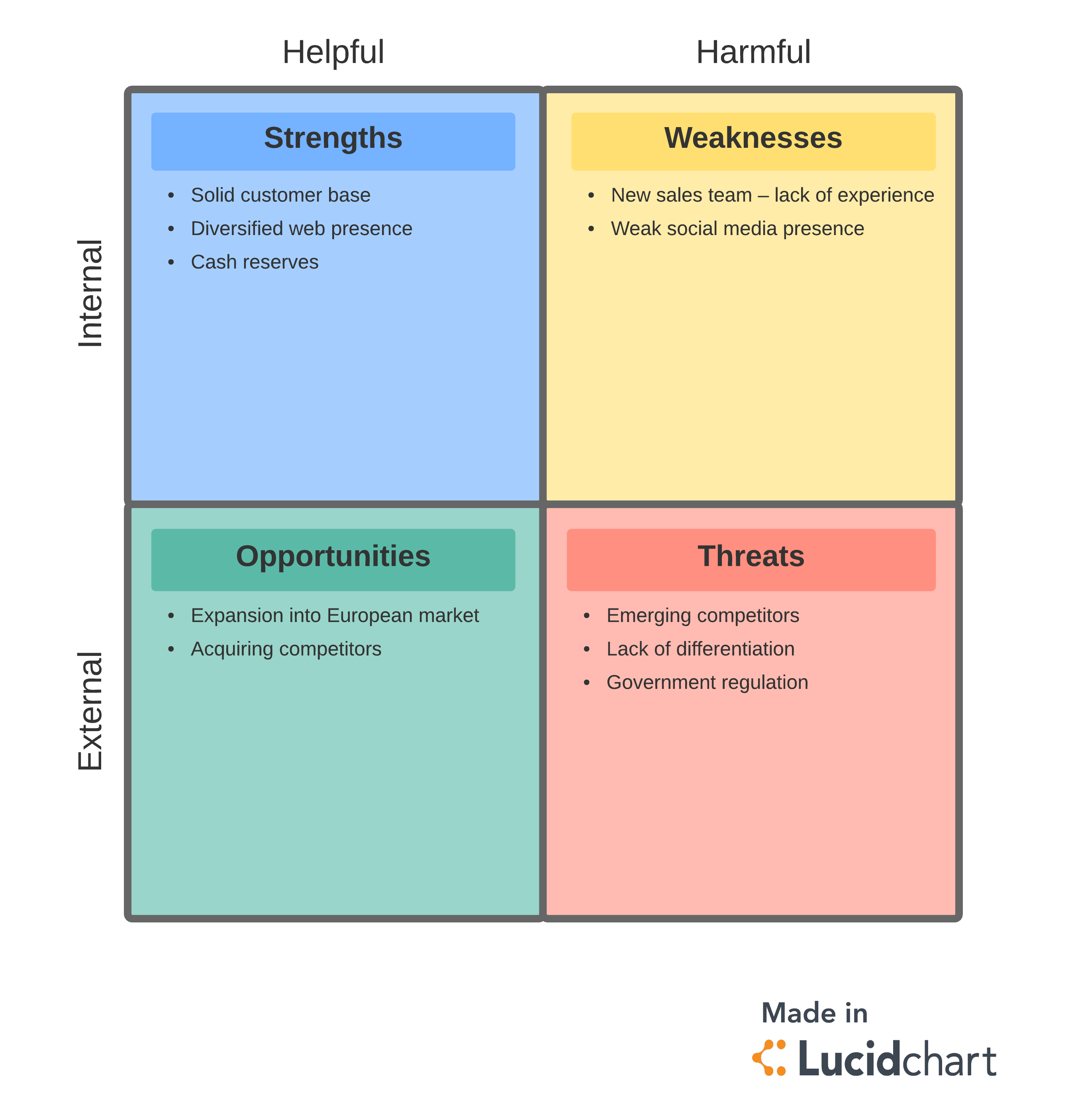What Is a gap analysis?
A gap analysis process helps organizations determine how to achieve their business goals. It compares the current state with an ideal state, which highlights shortcomings and opportunities for improvement.
How do you know what to trim, fix, expand, or change to get your business to the next level? You do a gap analysis.
You might have lots of guesses about what’s going on, and your team might have different opinions on how to meet your objectives. Rather than groping around in the dark, a gap analysis leads you through a detailed examination of where your organization is currently and where you want to be so you can act on facts, not assumptions, to reach your potential.
If you’re wondering how to do a gap analysis, follow these four simple steps. Regardless of your industry, you’ll be able to apply these tips across any discipline and meet your business goals.
1. Analyze your current state
First, you’ll need to choose which area of your business you want to focus on and start with your current state. You need to discover where your organization currently is before you can make a plan for reaching your goals.
For example, your company wants to become the most loved in your industry, but your customer support team reports that many calls and customer interactions end with customers feeling frustrated.
Is your product the problem or does your support team need more training on handling difficult calls? You won’t know until you dig in, which will mean talking to the people involved, gathering data, and scrutinizing your KPIs. To make sense of this information and visualize your current state, use a gap analysis tool––a customer journey map, empathy map, service blueprint, or process flow.
If you wanted to find out what causes customer frustration, you might gather quantitative information, like your company’s NPS score or the number of negative calls handled each week. You might also look at qualitative information, like customer comments or feedback from your support reps on the current call process.
Even if you’re looking to analyze a more strategic area of your business, the process remains the same. A sales team with the same company vision––becoming the best-loved company in the industry––might examine the sales reps’ product pitch as well as sales growth, targets, and conversion rates.
What’s most important at this stage is understanding the root of the problem, which is much easier to see once you’ve laid out all the contributing factors. In fact, your gap analysis process should evaluate everything you currently do so you get the “big picture.”

Study and visualize your current state to increase your efficiency and performance.
Read more2. Identify the ideal future state
Once you have the big picture figured out and understand how your team or organization currently functions, you need to become idealistic. Where would you like to be? What’s not happening that should be? Don’t worry yet about how you’ll get there; that’s the next step. Right now, the sky’s the limit, and you should dream big.
Maybe you have an exceptional marketing team that outsources all its content, but after performing a content audit, you realize that your brand is no longer cohesive because it’s handled by a disparate group of freelancers. Your dream could be to regain control of the content creation process in order to reclaim your brand identity.
Another example might be of a warehouse needing to meet certain safety regulations, but the production and human resource managers decide that they want to do more than meet them. Their ideal would be to exceed what’s mandated so they can attract and retain more talented and dedicated workers.
In both scenarios, current performance clearly falls short or needs to be changed. But instead of charging blindly ahead or slapping a Band-Aid on the situation, picturing the ideal helps you reach a higher potential. A good gap analysis tool here would be a brainstorming board or a mind map to really capitalize on your team’s creativity.
But how do you really get to the ideal? That’s where the hard work comes in.
3. Find the gap and evaluate solutions
Completing the first two steps in isolation won’t get you great results––the status quo can seem inescapable, and goals can feel lofty and unattainable. Putting them together, however, exposes what’s missing between your performance and your potential. You also need to decide which solutions will most effectively bridge the gap.
Returning to our example in step 2 involving a marketing team, a gap analysis would bring up the following question: How do we go from a muddled brand voice to one that’s unified and under our control?
Several solutions for bridging this gap present themselves, though not all are created equal:
- You could bring content creation back in-house by hiring more full-time writers, which would be more expensive than using freelancers.
- You could reevaluate all of your freelancers to determine which ones are worth keeping and which are falling short of your standards. This option would require some time and might result in not having enough freelancers to handle your needs.
- You could tighten your brand creation guidelines and retrain your freelancers. This option would also require time and doesn’t necessarily guarantee an improvement in the content created by your freelancers.
If guaranteed control matters most, then the first solution is best. On the other hand, if cost tops the list, then the first solution will be out, and your team might choose the second or third solution. A helpful gap analysis tool would be a decision tree as it calculates costs and benefits based on conditional probability.
In the end, how you bridge the gap will depend on your organizational and team priorities. Work together to find what works best.
4. Create and implement a plan to bridge the gap
After you’ve charted out the possible ways to bridge the gap and decided which would be best, you likely still need to convince others in your organization of that as well. The changes that you’ll implement may also affect other teams and departments, so it’s important to come up with a plan.
Establish a clear strategy and actionable objectives to help you get everyone on board.
For example, when presenting to management or executives, have a timeline or schedule for rolling out the planned changes. You could also create a more comprehensive action plan that assigns specific tasks to teams or individuals.
Keep reading about organizational change management, or use the tools described below to help you during this gap analysis process.
Gap analysis tools
Many tools exist to help you bridge the gap. Whichever tool you choose, visualize and document each step of your gap analysis to keep your organization moving forward.
SWOT analysis
SWOT analysis is perhaps one of the oldest textbook-marketing assets. SWOT stands for strengths, weaknesses, opportunities, and threats. You can perform a SWOT analysis both quantitatively and qualitatively. This process will help you determine internal and external threats to your organization and see where and how you stand out against the competition. Try our SWOT analysis template or competive analysis template to help you organize your research.

Fishbone diagram
Named for their distinctive shape, fishbone diagrams (also known as Ishikawa, cause-and-effect, or herringbone diagrams) explore the possible causes of a root problem. This type of diagram would be especially valuable when examining your current situation.
The most commonly used categories for investigation are:
- Measurements
- Materials
- People
- Machines
- Methods
- Environment
You can choose any categories that make sense for the central problem or effect you’re examining, as shown in the example below.

McKinsey 7S framework
The McKinsey 7S framework was developed by its eponymous consulting firm. It helps determine whether a company is meeting expectations. It works through seven aspects of an organization to see what values cross over. Additionally, this framework bridges the gap between the company’s present and desired states.
Nadler-Tushman Model
Perhaps the most dynamic of the models, the Nadler-Tushman model examines how each business process affects another and identifies which gaps affect efficiency. It creates a holistic view of your organization’s operational processes from beginning (input) to end (output).
The model finds gaps by dividing your organization's processes into three groups:
- Input: Entire company culture and workforce, all resources used to create product/service, and operational environment
- Transformation: The systems, teams, and processes that take the input value(s) and turn them into the output product
- Output: The final product or service
PEST analysis
Similar to SWOT, PEST analysis helps you identify threats and opportunities by examining the four primary external factors of your business environment:
- Political
- Economic
- Sociological
- Technological
This approach eliminates gaps by pinpointing current issues, highlighting opportunities for change, and minimizing risks in the market.
If you want to do a more in-depth analysis of your market environment, try a PESTLE analysis instead, as it adds legal and environmental factors to the PEST analysis.
The gap analysis process is essential for any business to streamline their operations for efficiency and cost-effectiveness.

The gap analysis process is essential for any business to streamline their operations for efficiency and cost-effectiveness.
Read moreAbout Lucidchart
Lucidchart, a cloud-based intelligent diagramming application, is a core component of Lucid Software's Visual Collaboration Suite. This intuitive, cloud-based solution empowers teams to collaborate in real-time to build flowcharts, mockups, UML diagrams, customer journey maps, and more. Lucidchart propels teams forward to build the future faster. Lucid is proud to serve top businesses around the world, including customers such as Google, GE, and NBC Universal, and 99% of the Fortune 500. Lucid partners with industry leaders, including Google, Atlassian, and Microsoft. Since its founding, Lucid has received numerous awards for its products, business, and workplace culture. For more information, visit lucidchart.com.
Related articles
How to define strategy using Porter’s Five Forces
What is strategy? According to Michael Porter, it's “choosing a different set of activities to deliver a unique mix of value.” Learn about Porter's Five Forces to understand your competition and find your position in the market.
5 steps of the strategic planning process
Implement the strategic planning process to make measurable progress toward achieving your company’s vision and make decisions that will keep you on the path to success for years to come.

